Yuting Zhang
Period-LLM: Extending the Periodic Capability of Multimodal Large Language Model
May 30, 2025Abstract:Periodic or quasi-periodic phenomena reveal intrinsic characteristics in various natural processes, such as weather patterns, movement behaviors, traffic flows, and biological signals. Given that these phenomena span multiple modalities, the capabilities of Multimodal Large Language Models (MLLMs) offer promising potential to effectively capture and understand their complex nature. However, current MLLMs struggle with periodic tasks due to limitations in: 1) lack of temporal modelling and 2) conflict between short and long periods. This paper introduces Period-LLM, a multimodal large language model designed to enhance the performance of periodic tasks across various modalities, and constructs a benchmark of various difficulty for evaluating the cross-modal periodic capabilities of large models. Specially, We adopt an "Easy to Hard Generalization" paradigm, starting with relatively simple text-based tasks and progressing to more complex visual and multimodal tasks, ensuring that the model gradually builds robust periodic reasoning capabilities. Additionally, we propose a "Resisting Logical Oblivion" optimization strategy to maintain periodic reasoning abilities during semantic alignment. Extensive experiments demonstrate the superiority of the proposed Period-LLM over existing MLLMs in periodic tasks. The code is available at https://github.com/keke-nice/Period-LLM.
Sage Deer: A Super-Aligned Driving Generalist Is Your Copilot
May 15, 2025Abstract:The intelligent driving cockpit, an important part of intelligent driving, needs to match different users' comfort, interaction, and safety needs. This paper aims to build a Super-Aligned and GEneralist DRiving agent, SAGE DeeR. Sage Deer achieves three highlights: (1) Super alignment: It achieves different reactions according to different people's preferences and biases. (2) Generalist: It can understand the multi-view and multi-mode inputs to reason the user's physiological indicators, facial emotions, hand movements, body movements, driving scenarios, and behavioral decisions. (3) Self-Eliciting: It can elicit implicit thought chains in the language space to further increase generalist and super-aligned abilities. Besides, we collected multiple data sets and built a large-scale benchmark. This benchmark measures the deer's perceptual decision-making ability and the super alignment's accuracy.
OThink-MR1: Stimulating multimodal generalized reasoning capabilities through dynamic reinforcement learning
Mar 20, 2025Abstract:Multimodal Language Models have gained significant traction for their ability to process diverse input data types and generate coherent, contextually relevant outputs across various applications. While supervised fine-tuning (SFT) has been the predominant approach to enhance MLLM capabilities in task-specific optimization, it often falls short in fostering crucial generalized reasoning abilities. Despite the potential of reinforcement learning (RL) to address these limitations, it faces two issues: (1) its generalized capabilities in multimodal tasks remain underexplored. (2) its training constraints such as constant Kullback-Leibler or clamp strategy easily lead to suboptimal bottleneck. To adress these issues, we introduce OThink-MR1, a framework that extends RL to MLLMs, enabling them to achieve deeper understanding and reasoning across multimodal tasks. We design a dynamic Kullback-Leibler strategy that significantly enhances RL performance, surpassing SFT in same-task evaluations. Also, we are the first to reveal that RL exhibits remarkable cross-task generalization capabilities, which shows that models post-trained with RL on one multimodal task can be effectively transfered to another tasks. Finally, extensive experiments demonstrate the great reasoning ability of our proposed OThink-MR1.
A Comprehensive Survey on Self-Interpretable Neural Networks
Jan 26, 2025Abstract:Neural networks have achieved remarkable success across various fields. However, the lack of interpretability limits their practical use, particularly in critical decision-making scenarios. Post-hoc interpretability, which provides explanations for pre-trained models, is often at risk of robustness and fidelity. This has inspired a rising interest in self-interpretable neural networks, which inherently reveal the prediction rationale through the model structures. Although there exist surveys on post-hoc interpretability, a comprehensive and systematic survey of self-interpretable neural networks is still missing. To address this gap, we first collect and review existing works on self-interpretable neural networks and provide a structured summary of their methodologies from five key perspectives: attribution-based, function-based, concept-based, prototype-based, and rule-based self-interpretation. We also present concrete, visualized examples of model explanations and discuss their applicability across diverse scenarios, including image, text, graph data, and deep reinforcement learning. Additionally, we summarize existing evaluation metrics for self-interpretability and identify open challenges in this field, offering insights for future research. To support ongoing developments, we present a publicly accessible resource to track advancements in this domain: https://github.com/yangji721/Awesome-Self-Interpretable-Neural-Network.
Unified Dual-Intent Translation for Joint Modeling of Search and Recommendation
Jul 01, 2024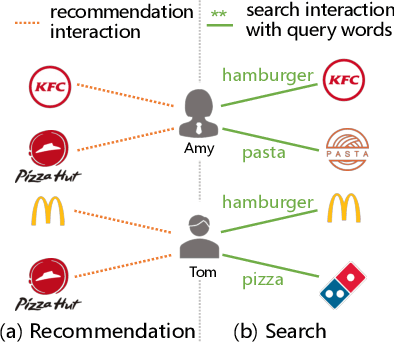
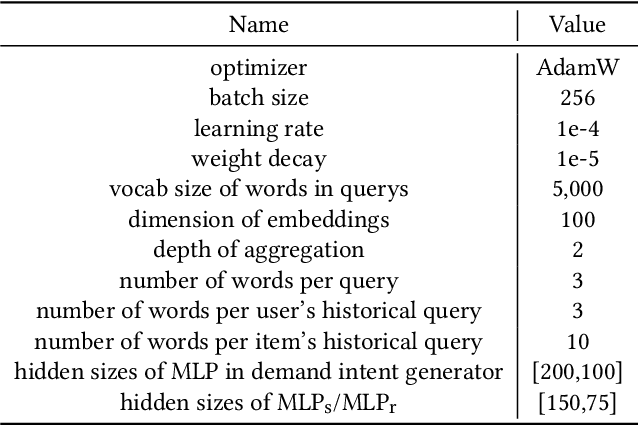
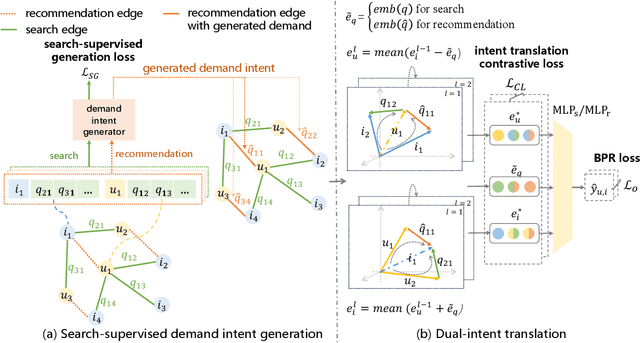
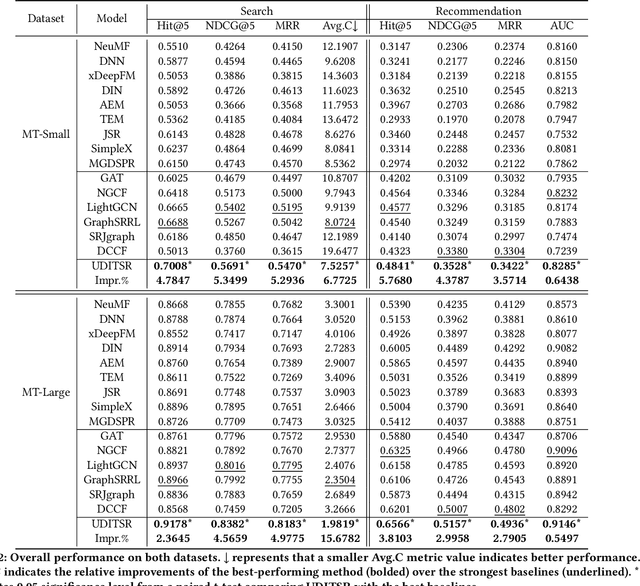
Abstract:Recommendation systems, which assist users in discovering their preferred items among numerous options, have served billions of users across various online platforms. Intuitively, users' interactions with items are highly driven by their unchanging inherent intents (e.g., always preferring high-quality items) and changing demand intents (e.g., wanting a T-shirt in summer but a down jacket in winter). However, both types of intents are implicitly expressed in recommendation scenario, posing challenges in leveraging them for accurate intent-aware recommendations. Fortunately, in search scenario, often found alongside recommendation on the same online platform, users express their demand intents explicitly through their query words. Intuitively, in both scenarios, a user shares the same inherent intent and the interactions may be influenced by the same demand intent. It is therefore feasible to utilize the interaction data from both scenarios to reinforce the dual intents for joint intent-aware modeling. But the joint modeling should deal with two problems: 1) accurately modeling users' implicit demand intents in recommendation; 2) modeling the relation between the dual intents and the interactive items. To address these problems, we propose a novel model named Unified Dual-Intents Translation for joint modeling of Search and Recommendation (UDITSR). To accurately simulate users' demand intents in recommendation, we utilize real queries from search data as supervision information to guide its generation. To explicitly model the relation among the triplet <inherent intent, demand intent, interactive item>, we propose a dual-intent translation propagation mechanism to learn the triplet in the same semantic space via embedding translations. Extensive experiments demonstrate that UDITSR outperforms SOTA baselines both in search and recommendation tasks.
Development of Automated Neural Network Prediction for Echocardiographic Left ventricular Ejection Fraction
Mar 18, 2024

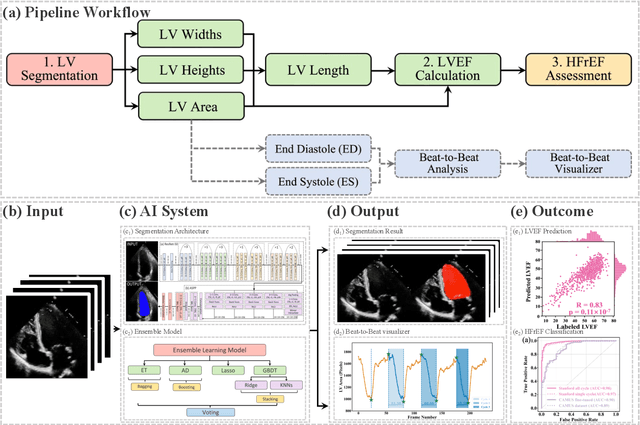
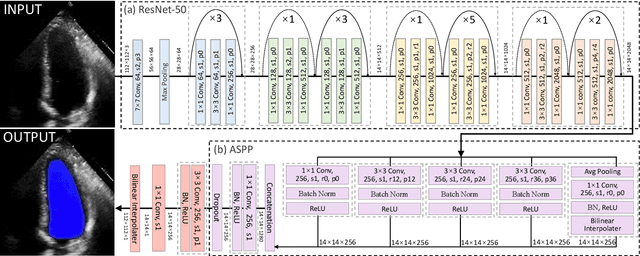
Abstract:The echocardiographic measurement of left ventricular ejection fraction (LVEF) is fundamental to the diagnosis and classification of patients with heart failure (HF). In order to quantify LVEF automatically and accurately, this paper proposes a new pipeline method based on deep neural networks and ensemble learning. Within the pipeline, an Atrous Convolutional Neural Network (ACNN) was first trained to segment the left ventricle (LV), before employing the area-length formulation based on the ellipsoid single-plane model to calculate LVEF values. This formulation required inputs of LV area, derived from segmentation using an improved Jeffrey's method, as well as LV length, derived from a novel ensemble learning model. To further improve the pipeline's accuracy, an automated peak detection algorithm was used to identify end-diastolic and end-systolic frames, avoiding issues with human error. Subsequently, single-beat LVEF values were averaged across all cardiac cycles to obtain the final LVEF. This method was developed and internally validated in an open-source dataset containing 10,030 echocardiograms. The Pearson's correlation coefficient was 0.83 for LVEF prediction compared to expert human analysis (p<0.001), with a subsequent area under the receiver operator curve (AUROC) of 0.98 (95% confidence interval 0.97 to 0.99) for categorisation of HF with reduced ejection (HFrEF; LVEF<40%). In an external dataset with 200 echocardiograms, this method achieved an AUC of 0.90 (95% confidence interval 0.88 to 0.91) for HFrEF assessment. This study demonstrates that an automated neural network-based calculation of LVEF is comparable to expert clinicians performing time-consuming, frame-by-frame manual evaluation of cardiac systolic function.
Advancing Generalizable Remote Physiological Measurement through the Integration of Explicit and Implicit Prior Knowledge
Mar 11, 2024



Abstract:Remote photoplethysmography (rPPG) is a promising technology that captures physiological signals from face videos, with potential applications in medical health, emotional computing, and biosecurity recognition. The demand for rPPG tasks has expanded from demonstrating good performance on intra-dataset testing to cross-dataset testing (i.e., domain generalization). However, most existing methods have overlooked the prior knowledge of rPPG, resulting in poor generalization ability. In this paper, we propose a novel framework that simultaneously utilizes explicit and implicit prior knowledge in the rPPG task. Specifically, we systematically analyze the causes of noise sources (e.g., different camera, lighting, skin types, and movement) across different domains and incorporate these prior knowledge into the network. Additionally, we leverage a two-branch network to disentangle the physiological feature distribution from noises through implicit label correlation. Our extensive experiments demonstrate that the proposed method not only outperforms state-of-the-art methods on RGB cross-dataset evaluation but also generalizes well from RGB datasets to NIR datasets. The code is available at https://github.com/keke-nice/Greip.
GPT as Psychologist? Preliminary Evaluations for GPT-4V on Visual Affective Computing
Mar 09, 2024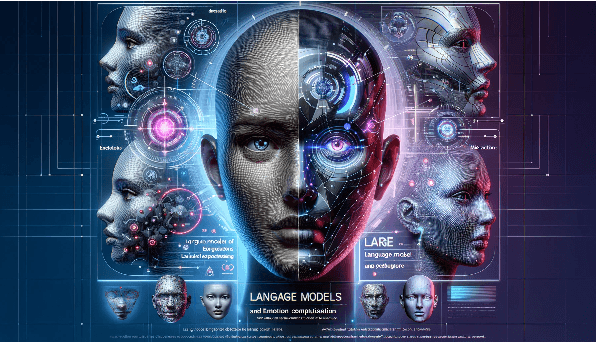

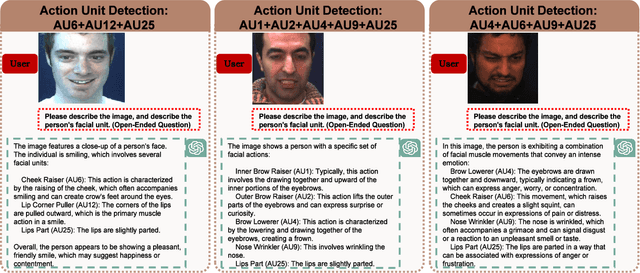
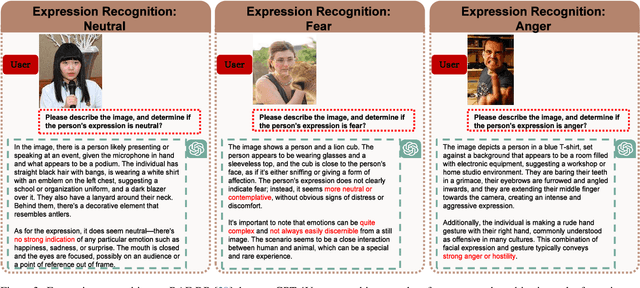
Abstract:Multimodal language models (MLMs) are designed to process and integrate information from multiple sources, such as text, speech, images, and videos. Despite its success in language understanding, it is critical to evaluate the performance of downstream tasks for better human-centric applications. This paper assesses the application of MLMs with 5 crucial abilities for affective computing, spanning from visual affective tasks and reasoning tasks. The results show that GPT4 has high accuracy in facial action unit recognition and micro-expression detection while its general facial expression recognition performance is not accurate. We also highlight the challenges of achieving fine-grained micro-expression recognition and the potential for further study and demonstrate the versatility and potential of GPT4 for handling advanced tasks in emotion recognition and related fields by integrating with task-related agents for more complex tasks, such as heart rate estimation through signal processing. In conclusion, this paper provides valuable insights into the potential applications and challenges of MLMs in human-centric computing. The interesting samples are available at \url{https://github.com/LuPaoPao/GPT4Affectivity}.
BFRFormer: Transformer-based generator for Real-World Blind Face Restoration
Feb 29, 2024Abstract:Blind face restoration is a challenging task due to the unknown and complex degradation. Although face prior-based methods and reference-based methods have recently demonstrated high-quality results, the restored images tend to contain over-smoothed results and lose identity-preserved details when the degradation is severe. It is observed that this is attributed to short-range dependencies, the intrinsic limitation of convolutional neural networks. To model long-range dependencies, we propose a Transformer-based blind face restoration method, named BFRFormer, to reconstruct images with more identity-preserved details in an end-to-end manner. In BFRFormer, to remove blocking artifacts, the wavelet discriminator and aggregated attention module are developed, and spectral normalization and balanced consistency regulation are adaptively applied to address the training instability and over-fitting problem, respectively. Extensive experiments show that our method outperforms state-of-the-art methods on a synthetic dataset and four real-world datasets. The source code, Casia-Test dataset, and pre-trained models are released at https://github.com/s8Znk/BFRFormer.
DocTr: Document Transformer for Structured Information Extraction in Documents
Jul 16, 2023Abstract:We present a new formulation for structured information extraction (SIE) from visually rich documents. It aims to address the limitations of existing IOB tagging or graph-based formulations, which are either overly reliant on the correct ordering of input text or struggle with decoding a complex graph. Instead, motivated by anchor-based object detectors in vision, we represent an entity as an anchor word and a bounding box, and represent entity linking as the association between anchor words. This is more robust to text ordering, and maintains a compact graph for entity linking. The formulation motivates us to introduce 1) a DOCument TRansformer (DocTr) that aims at detecting and associating entity bounding boxes in visually rich documents, and 2) a simple pre-training strategy that helps learn entity detection in the context of language. Evaluations on three SIE benchmarks show the effectiveness of the proposed formulation, and the overall approach outperforms existing solutions.
 Add to Chrome
Add to Chrome Add to Firefox
Add to Firefox Add to Edge
Add to Edge